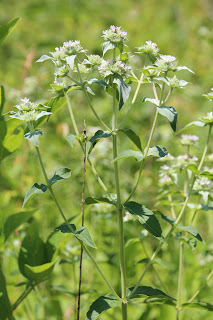Newly formed goldenrod gall
June's edition of the One Trail Twelve Times series of hikes was scheduled for Sunday afternoon, June 24. As those of you who have been following my postings about the walks, attendance has dropped off precipitously since January (is it me?), so I didn't hold out much hope for a crowd for June's walk. Kali posited that one reason people don't accompany me may be that I take too long taking photographs as we walk, so she and I decided to walk the trail ourselves on Sunday morning to scout out interesting changes in the landscape, to take pictures, and - because the day was forecast to be uncomfortably warm, which might discourage people from taking a mid-afternoon walk - to make sure we had documented the trail's attractions in their early summer glory even if no one came to hike.
As it turned out, one individual, a loyal member of our organization, showed up at 2:10 p.m., just as I was about to give up hope and return home having been stood up by my public. So, this member and I walked the trail and found several things Kali and I had overlooked, like the brand new goldenrod gall pictured above.
Though the Beech Springs Trail begins in woods, emerges into meadows, and then re-enters a woods, I've elected to group the meadow images together, followed by a relatively few woodland images.
Trail trough the meadow. The white flowers on the right are non-native but well-behaved yarrow (Achillea millefolium).
As we walked during the "official" walk in the afternoon, we were overtaken by an equestrian (who shouldn't be using this trail).
One of the knapweeds (Centaurea spp.), another well-behaved non-native. Members of this genus are a scourge further west.
The meadow was full of blooming summer wildflowers. Here's a sampling of the most common.
White avens (Geum canadense)
Black-eyed Susans (Rudbeckia serotina)
Common milkweed (Asclepias syriaca) with a shy bumblebee
Mountain mint (Pycnanthemum spp.), which has a heavenly scent reminiscent of peppermint when crushed
Almost ripe! (Rubus spp.)
In the wet meadow
Nodding Wild Onion (Allium cernuum)
Red Clover (Trifolium pratense), a ubiquitous non-native species, offering nectar to a native bee
Our neighbor, whose driveway bisects the meadow, maintains apple trees (Malus spp.) that delight the deer (and hikers) later in the season.
Two non-natives, neither benign - a Japanese beetle (Popillia japonica) on porcelainberry (Ampelopsis brevipedunculata)
And, last but not least (for the meadow), a New England Aster (Aster novae-angliae) blooming at least two months early!
In the woodlands, the squirrels have harvested the fruit from the spring ephemeral Mayapple (Podophyllum peltatum), and the plants are declining.
Beech Springs, with skunk cabbage (Symplocarpus foetidus) looking a bit worse for wear.
A Pileated Woodpecker continues its excavations. The hole beneath the neat rectangle is new this month.
Tuliptree flowers (Liriodendron tulipifera) are maturing into seed clusters...
...that blow into the meadows, become established, and advance natural succession.
























4 comments:
It looks like a really nice trail to me. I think some of your summer flowers are a bit further along than mine. So far, I'm not seeing that many of the summer blooms.
There were lots of other summer blooms that I didn't post, including Hop-clover, an attractive plant I had never noticed before. The New York Ironweed stalks have grown tall and look like they'll be blooming any day now, too. Thanks for coming along for the walk, Carolyn.
Love the photos, Scott! When you do the 12 Hikes next year make it mandatory that your students to accompany you.
I may do a "One Trail 12 Times" series next year, Packrat, but I'm not going to invite the public to join me. That way, I can walk (and document) at my convenience and not be locked into Sunday afternoons. Actually, to mix it up a bit, July's walk will be an evening walk on Tuesday, July 17; maybe I'll get more folks to join me then.
Post a Comment